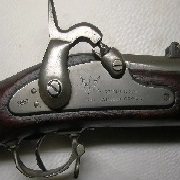|
ChubbyChecker posted:Did the typists, clerks, cooks etc. have the same basic training as riflemen had, or were they trained only for their job? We are reaching the limits of what I remember off the top of my head, but my understanding is that each soldier would go through general basic training once they entered the army, so everybody would at least have fired a weapon at some point, maybe done some very basic maneuvering, but that was it.
|
|
|
|

|
| # ? Jun 11, 2024 14:08 |
|
Cessna posted:In contrast today the practice it to rotate UNITS, not individuals. So you'll go to boot camp, infantry training, and an MOS school. Then you'll be sent to a unit that is starting it's work-up/training for a deployment, or is early on in the process. Then you'll train with the unit. THEN you'll deploy overseas with the people you trained with. You do your tour, then return to the states for a break, then start the process over again. This describes ARFORGEN, which was basically a custom-tailored solution for the GWOT missions. A couple of years ago everyone sat down and started thinking hard about how this would work in a protracted, conventional, high-intensity war, and came up with the answer "it wouldn't." It requires a very predictable schedule, a known mission, a known budget, and a known force level, all of which are possible in a long term counterinsurgency effort, but go out the window in a hurry in a proper shooting war. The army's response was the "Sustainable Readiness Model" which at least theoretically gets rid of the idea of the "cycle" and instead just keeps as many units as ready as possible for as long as possible. It is actually pretty well thought out, except that it requires a much more careful and accurate forecasting of big ticket end items and manpower, both of which are carefully tied to budget. And, we haven't had a proper budget for...ever. So, the lack of fiscal certainty creates this accordion effect with regard to maintenance and training, which makes previous forecasts bad, which ends up costing more money in the long term, which makes readiness more expensive, which leads to more frequent and larger budget requests, which creates an accordion effect with regard to maintenance and training....you get the idea. I don't have a solution to any of this by the way.
|
|
|
|
Cessna posted:(13 months for the USMC) Well that's kind of a dick move
|
|
|
|
bewbies posted:This describes ARFORGEN, which was basically a custom-tailored solution for the GWOT missions. I'll admit up front I'm more familiar with the USMC model than the Army. aphid_licker posted:Well that's kind of a dick move This describes the entirety of the USMC. Edit: No, that's not true. Wingers and Base types don't have it that bad. Combat Arms sucks. Compare: https://www.youtube.com/watch?v=5KW7_V9I-OI Cessna fucked around with this message at 18:38 on Dec 13, 2018 |
|
|
ChubbyChecker posted:Did the typists, clerks, cooks etc. have the same basic training as riflemen had, or were they trained only for their job? Every soldier would go through the same basic training involving the very basics of military life, such as PT and marksmanship qualification, and then be assigned their duty and given specific training for that. So the clerks and cooks all got the same basic training that a regular infantryman did, but they'd have no experience in the field beyond that. In terms of effectiveness, it would be like sending a conscript out to the front lines as soon as they finished boot camp.
|
|
|
|
|
I gotta say, I totally love the level of conversations here. People know their poo poo and I learn something new almost every day. Thank you!
|
|
|
|
Flipswitch posted:i was reading a ww2 book and she asked me about it
|
|
|
|
So funny enough, GURPS source books tend to be some of the best references for things like this because they're extremely well-researched and put a bibliography at the back. Dogfaces, the WW2 supplement for the US Army, goes into detail about enlistment and boot camp and has 13 listed reference books at the back. As far as I can see checking on this info elsewhere, none of it appears to be really incorrect and a lot of it isn't much different from the modern process. Soldiers would begin by receiving a classification test, which was essentially an intelligence test (as recruiting standards were lowered as the war went on, over half a million people were taught to read by the Army). The Army General Classification Test (AGCT) was a 40 minute test with 150 questions mostly checking general intelligence like vocabulary, basic arithmetic, and being able to do things like rearrange sentences or fill in missing spaces in a picture. The results were scored and soldiers sorted into Classes I through V, with Class I being the highest aptitude and Class V being borderline mentally disabled. Class II was the minimum for officer and pilot candidates. The recruit would then be interviewed to determine their background, preferences, and AGCT score and work that into the military's needs to see where they would best be suited; obviously you'd want civilian pilots to be prioritized for military pilots instead of handing them a machine gun to fight in Africa. Soldiers with physical deficiencies like flat feet or color blindness would be restricted to non-combat roles like clerical duty or hauling boxes. Some roles had more tests at the induction center and during training, and some soldiers would intentionally try to sabotage competitors for desired jobs. Once this was done, the soldier was sent to boot camp for basic training. Recruits were held at the reception station for about a week for processing, including shaving their heads (mainly as a way of preventing lice) and given their clothing, vaccinations, paperwork, and dog tags and ID cards. All recruits filled out a will and were encouraged to take out a life insurance policy on themselves for their family. From there, recruits were divided into platoons for training and spent the next several weeks in their barracks. A promising recruit would be made the leader of their platoon and tasked with making sure they were where they needed to be on time and that the barracks and soldiers remained good for inspection. Army and Marine training was 8 to 13 weeks, which for a time was reduced to 6 to 8 weeks to get more men on the field; the Navy settled on 6 weeks in 1942, but for a time was as low as 3 weeks. Early in the war, before the Replacement Depot system came into play around 1944, troops were trained in the cadre system. They were shipped to a stateside division or regimental training camp and trained by a cadre of experienced veterans and officers of the unit they were being inducted into. They would receive about 6 weeks of basic training, 8 weeks of technical & tactical training, and 3 weeks of field exercises and bivouac. Non-combat troops like cooks, drivers, and mechanics received their "common specialty training" during this time. Replacement training was essentially the same curriculum (minus any shortening), but each location was specialized to something like infantry, armor, signal corps, or field artillery and would just train recruits in that specialty before shipping them off to fill in gaps overseas. Cadre training camps still had access to specific equipment, like armored divisions would have tanks stateside to train on. The cadre system was less efficient at getting bodies into the fight, but it made for stronger bonds between the soldiers of that unit. The basic training that all soldiers received regardless of MOS included information on the chain of command and military regulations and standards, marching and close order drill, basic knowledge of infantry weapons (predominately the rifle, though they would possibly receive basic handling training for other weapons even if they couldn't qualify on them), hand-to-hand and bayonet combat (with recruits sparring with real steel blades!), grenade throwing, first aid, and lots and lots of PT to whip them into physical shape. Written and practical tests were given for things like radio procedures and map reading (especially in the Navy and technical fields) and competition between units and individuals was encouraged. Because platoons could lose privileges to slackers or really incompetent recruits, GIs would almost literally beat their comrades into shape. Training would end with a nighttime live fire exercise involving bullets flying overhead and explosives going off while crawling under barbed wire (which did occasionally result in serious injury or death) and the bivouac stage where recruits would dig fighting positions and live out in the field, engaging in mock battles and even gas attacks. At the end of basic, a soldier is assigned their MOS (Military Occupational Specialty) and marches in a graduation parade. They would usually get a few days' leave before either reporting to their unit or entering advanced training for their MOS. Most of the advanced training would be done during basic and grunts who didn't need anything additional would report to their unit right out of training, but specialized troops would receive more detailed training after basic from either a training school or their unit in the cadre system. Marines followed up boot camp with a 12-week combat training regimen that focused on the individual soldier's intended gear, like machine guns or mortars. Medics/corpsmen received 8 weeks of training on health and emergency lifesaving, including working in civilian and military hospitals. This is the period when you'd start seeing the use of live animals being wounded for medics to practice on, a controversial practice still in use today. After any advanced training was done, that was it. In the cadre system, soldiers would already be with their unit and get shipped out with them. In the replacement system, they would go straight to Europe or the Pacific to join whatever unit they were assigned to. With the need for convoys to protect from U-boats, a journey that would ordinarily take 4 or 5 days could take 2 or 3 weeks. Cadre-trained units would be quartered together and ready to head into combat when necessary. Once again, replacement soldiers just went straight to the front lines. One of the problems compounding the replacement system is that units in the field were forbidden from requesting replacements until after they already needed them, which is why they got shoved into the fight straight off the ship. They would arrive a reception depot, usually a big tent city, then be sent to a stockage depot (yet another tent city) for their equipment, weapons, and basic information on orientation, personal hygiene, how to avoid getting the clap from a French hooker, etc. Lucky soldiers got sent to a division's training center and would be given better preparation for combat, but most of them just languished in a replacement depot (the "repple depple") until it was time for them to be shipped into the fight. There was no oversight to make sure they stayed in good shape, so they usually just sat around smoking, eating, reading magazines, and hearing horror stories from vets and returning wounded. When it was time to go, an NCO would drive up with a list of men to find and usher them into a truck. They'd be dropped in pairs or threes at a command post near the front line, make their way to the unit with a supply sergeant after dark, and if they were lucky get to spend a few days at the company command post getting briefed. If they were needed, they went straight into a foxhole.
|
|
|
|
|
tankchat has gone too far
|
|
|
|
Well, there's my final drive gone
|
|
|
|
Also, the transport system with the long voyages wasn't really improved by Vietnam. I read The Boys of '67, which covers a single company's experiences in Vietnam from recruitment to the last of them returning stateside. The journey to Vietnam was a little faster due to better ships and no need for convoys to zig-zag around submarines, but it was still a long journey with nothing to do and a lot of men getting seasick (not aided by the lovely food, usually including powdered eggs). Some ships had projectors and could show movies on the journey, but most soldiers couldn't do much more than exercise, smoke, and read magazines. More than one soldier sprained or broke their ankle doing jumping jacks when they didn't time it with the roll of the ship.
|
|
|
|
|
Some troops were sent to Vietnam by ship, but the overwhelming majority were sent (and returned) by plane. More often than not this was a chartered airliner flown to Tan Son Nhut Air Base. At the height of the war this airbase was one of the busiest airports in the world. (Edit: Later other airbases - Bien Hoa, Cam Ranh Bay - were opened but most flights still went through Tan Son Nhut.) Regarding ships - when I worked on Pampanito (a submarine museum) one of our jobs was to go up to the "mothball fleet" in Suisun Bay. This was a group of old Navy ships parked and mostly abandoned, waiting for their final trip to the scrap yard. We got access to go onto them to strip useful parts for the museum, things like fittings that could be restored and put back into the sub. Some of the ships were old troopships that had been used to take guys over to Vietnam. There was a lot of ballpoint-pen graffiti written on the underside of the canvas bunks in the ship, things like rotation dates, names of girlfriends, that sort of thing. It was really interesting and a bit haunting; you couldn't help but wonder what happened to the guys who wrote those things.
|
|
|
|
Acebuckeye13 posted:The US could afford boondoggles like no one else (The bat bomb being an always fun and exciting example) though the mistake that cost them the most was probably Replacement Depots. For most countries, when a unit was sent into combat, that unit would be expected to be ground down over time, then pulled back to the rear, built up with replacements, and then eventually sent back to the front. The US, however, utalized a system of Replacement Depots, or the 'Repple-Depple' system. Instead of units being replenished when they were pulled off the line, units would be continually provided with fresh troops from the states or troops that had been previously wounded in combat but had recovered. I think the intention was that it would allow for combat units to remain on the front lines for longer, but it ended up being a corrosive mess for multiple reasons: One of the understated follow-on effects of this replacement system was that it significantly deteriorated the quality of the late-arriving US infantry divisions as they tended to have whole companies stripped out to become replacements, demolishing unit cohesion. This resulted in mediocre divisions like 99 and 106 ID hitting the front(106 creating the largest US surrender in the ETO against a single volksgrenadier division, the 12th) Also, the biggest technical boondoggle of the US was probably the B-29, despite it seeing service. Panzeh fucked around with this message at 21:19 on Dec 13, 2018 |
|
|
|
The two biggest US boondoggles, at least in terms of resources expended vs things usefully achieved, were 1) the Italian campaign and 2) the strategic bombing campaign. And even those were defensible in that the Western Allies needed to do something to strike back at Germany, and it wasn't like there was a whole bunch of other stuff they could have done with all those men and planes and supplies. Every gun and every shell fired against US and UK forces was one that wasn't being fired on the Eastern Front, and in 1942-44, that was justification enough. For my money, the biggest boondoggle of all of WWII was the German surface fleet. So much steel, so much fuel, so many trained personnel, and all for a return of...one British BC blasted to smithereens and a couple of dozen merchantmen sunk. Meanwhile, the U-boat effort was run on a comparative shoestring and came as close as anything to knocking the Brits out of the war.
|
|
|
|
Panzeh posted:Also, the biggest technical boondoggle of the US was probably the B-29, despite it seeing service. How so?
|
|
|
|
FMguru posted:The two biggest US boondoggles, at least in terms of resources expended vs things usefully achieved, were 1) the Italian campaign and 2) the strategic bombing campaign. And even those were defensible in that the Western Allies needed to do something to strike back at Germany, and it wasn't like there was a whole bunch of other stuff they could have done with all those men and planes and supplies. Every gun and every shell fired against US and UK forces was one that wasn't being fired on the Eastern Front, and in 1942-44, that was justification enough. I've read a lot itt about how strategic bombing in WWII wasn't very effective, so if you guys were transported back in time to 1941 and given sole power over the US Army Air Corps in the ETO, how would you conduct the bombing campaign to better effect, or was that just not possible with the tech available
|
|
|
|
Taerkar posted:Most E2s were built with 75mm guns as they were intended to attack fortified positions, places where the superior HE shell of the 75 would be better than the 76. Some broke down because they broke down. The T-34's mechanical reliability wasn't the greatest until production, maintenance, and training improved. Sort of like many other vehicles when they first go through the motions of a war.
|
|
|
|
B-29 development was a hideously expensive, accident-prone nightmare, but at the end of it the United States came out of it with the most advanced bomber anywhere (Arado Ar 234 possibly excepted,) and various outgrowths of the project were useful for years (tankers and so on based on the B-29 airframe, for example.) Moreover, all the resources put into the B-29 didn't stop the various bomber production pools from churning out over 20,000 B-17s and B-24s in the interim.
|
|
|
|
thanks!
|
|
|
Panzeh posted:One of the understated follow-on effects of this replacement system was that it significantly deteriorated the quality of the late-arriving US infantry divisions as they tended to have whole companies stripped out to become replacements, demolishing unit cohesion. This resulted in mediocre divisions like 99 and 106 ID hitting the front(106 creating the largest US surrender in the ETO against a single volksgrenadier division, the 12th) The same GURPS source book also mentions that some American divisions spent up to 300 consecutive days in combat and endured as much as 200% casualties through the replacement system.
|
|
|
|
|
StandardVC10 posted:B-29 development was a hideously expensive, accident-prone nightmare, but at the end of it the United States came out of it with the most advanced bomber anywhere (Arado Ar 234 possibly excepted,) and various outgrowths of the project were useful for years (tankers and so on based on the B-29 airframe, for example.) Moreover, all the resources put into the B-29 didn't stop the various bomber production pools from churning out over 20,000 B-17s and B-24s in the interim. Those are my thoughts on it too, so wondering why Panzeh thinks it was a boondoggle. There are still B-29 creations flying today (the Super Guppies). The KC-97 served right up into 1978.... No its not B-52 or KC-135 time in service, but it sure wasn't short.
|
|
|
|
Pretty sure it's just the Super Guppy, at this point, all the rest besides NASA's have been retired. But it's a hell of a thing.
|
|
|
|
zoux posted:I've read a lot itt about how strategic bombing in WWII wasn't very effective, so if you guys were transported back in time to 1941 and given sole power over the US Army Air Corps in the ETO, how would you conduct the bombing campaign to better effect, or was that just not possible with the tech available Forget the manufacturing targets and focus on the fuel and oil refineries and production centers earlier. And all their synthetic plants. Oil oil oil 24/7. Though I feel that the narrative of the Strategic Bombing campaign’s ineffectiveness is overrated. It wasn’t immediately apparent in the post war assessments but more recent evaluations show that it was a very significant factor in Germany’s ability to wage war. Not to mention that through it the Luftwaffe was gradually annihilated.
|
|
|
|
Shimrra Jamaane posted:Forget the manufacturing targets and focus on the fuel and oil refineries and production centers earlier. And all their synthetic plants. Oil oil oil 24/7. The actual destroy stuff with bombs part wasn't as effective as hoped but getting a huge portion of German aircraft and artillery production directed toward defense of Germany instead of the eastern front was indirectly very effective.
|
|
|
|
I think the conclusion around strategic bombing is mostly that bombing cities wasn’t effective and you didn’t need as many bombers for the other missions. So basically that you could have gotten the same benefit for less effort and fewer civilian casualties.
|
|
|
|
Jobbo_Fett posted:Some broke down because they broke down. The T-34's mechanical reliability wasn't the greatest until production, maintenance, and training improved. Sort of like many other vehicles when they first go through the motions of a war. Oh yeah, most certainly, though this was also exacerbated by the inexperience of the crews operating most of them at the beginning of the invasion. For most I would imagine it was their first time operating a motor vehicle (much like in most countries at the time). Stop the invading hordes with this thing you know absolutely nothing about!
|
|
|
|
Comrade Gorbash posted:I think the conclusion around strategic bombing is mostly that bombing cities wasn’t effective and you didn’t need as many bombers for the other missions. So basically that you could have gotten the same benefit for less effort and fewer civilian casualties. The majority of the reason they started bombing cities was because they couldnt hit anything else. They largely couldnt even hit cities.
|
|
|
|
Comrade Gorbash posted:I think the conclusion around strategic bombing is mostly that bombing cities wasn’t effective and you didn’t need as many bombers for the other missions. So basically that you could have gotten the same benefit for less effort and fewer civilian casualties. Only like 1 of 100 bombs dropped landed within a mile of the target so they actually really did need that many bombers.
|
|
|
|
To provide a counter to the American system, I also have books on other European nations. They're not as detailed, but they have some important information and they're accurate enough that they could be used as a primer on the nations involved. For the British, there was still a large class gap between officers and enlisted. Many officers came from wealthy and/or prominent families and promotions were preferentially given to officers from noble families or prestigious academies. Even if they rose to high ranks, they could expect to have their accomplishments ignored or attributed to others of higher status. The enlisted men didn't have much comment on this, as it was just following centuries of tradition. Other Commonwealth nations didn't see this problem occur until they started reaching ranks above lieutenant colonel. In May 1939, conscription was started for men aged 20 and 21. It was quickly expanded to all men between 18 and 41, which then resulted in conscription of unmarried women between 20 and 30 and eventually single or childless women up to the age of 43 to try and fill in the non-combatant roles that men had been pulled out of for soldier duty. This is why the British in WW2 had such a huge number of female non-combatants (over 640,000). Men who were too old, young, or sickly to join the military or deferred from conscription due to working in a particular industry were put on the Home Guard, who never really got much better than surplus World War I gear and often had to make do with hunting weapons and farming implements for weapons. 10% of all male conscripts (and some volunteers) were also sent to the coal mines instead of military service, known as Bevin Boys after Ernest Bevin, Minister of Labour and National Service. A lot of the coal miners wished they were soldiers instead, both due to the higher prestige of military service (including some mockery of them, such as accusations of dodging out on service) and the dangerous working conditions endemic to every coal mine of the time. They also weren't issued uniforms, which resulted in a lot of them being harassed by the police who mistook them for draft dodgers. The Bevin Boys included the infamous Jimmy Savile in their ranks. --------- The German book has more information on their training. From 1933 until 1945, the only official youth organization in Germany was the Hitler Youth. It served as a paramilitary organization for boys aged 14 to 18, indoctrinating them into the Nazi ideology. While it started as a Boy Scout analogue to make up for the Boy Scouts being banned in Germany, it quickly took on an overtly militaristic tone and began training boys in marksmanship, military tactics, and even assault courses to better prepare them for a future as conquerors or defenders. Eventually attendance became mandatory and Hitler Youth made up the majority of each year's new recruits, which is one of the reasons the "Most of the German soldiers weren't Nazis!" argument doesn't hold water. It's like saying that most American soldiers didn't say the Pledge of Allegiance in school. At the age of 18 (17 in 1945), the typical young German man was conscripted in the Musterung; when Hitler introduced conscription in 1935, every German male (and every Austrian male after the annexation) between 18 and 45 was registered. Much like the Americans, they were interviewed and sorted into classes based on their aptitude and current experience. Aktiv Dienende was the highest rating, already on active service, followed by Reserve I, who were under 35 and already trained. The lowest was Landsturm II, untrained men over the age of 45. All Reserve-class registrants were given instructions to report to a training center after their classification. As the war progressed, even Landsturm II were being used by 1944. Eager youths could volunteer by 17 (16 in 1944) and boys as young as 14 started serving on the front lines by the end of the war, though it was more common for the especially young or old to serve as anti-aircraft gunners or firefighters. Before the war, conscripts under the age of 20 weren't used as soldiers. If they were unemployed, they were required to sign up for the Reichsarbeitsdienst, or National Labor Service. They worked on public works programs in a military fashion, even marching with shovels over their shoulders, but their drill sergeants would laugh at the idea that they had learned anything of value for the military. Germany and Austria were divided into 15 geographic military districts (4 of which had no geographic ties and actually hosted soldiers from across the Reich or assumed command of other regions' vehicles), so recruits would be sent to their district's Replacement unit for training; the intention was that each district would have identically numbered replacement units as doppelgangers of their units in the field being trained to replace them. Recruits with special skills or aptitude were likely to be sent to other districts instead of their units at home. Actual training was 16 weeks at the peak of German power, shrinking to 8 weeks as the war turned against them. After this would be a month or more of advanced training through field exercises. On the one hand, training was quite brutal and involved tactics like intentional sleep deprivation to acclimate soldiers to harsh field conditions; live fire exercises often involved the trainers actually aiming at recruits instead of shooting over their heads. On the other hand, they wanted soldiers to have a sense of personal initiative instead of just blind obedience to superior officers and some instructors would even socialize with recruits in the evening, motivating them through familial bonds and senses of honor instead of just fear. At least, those were the lucky recruits. Some instructors still subscribed to the Prussian system of education, involving harsh discipline and strict following of rules and regulations. -------- When the war began, Soviet training wasn't much different from other nations apart from plenty of political propaganda. By 1931, the USSR had an established system of paramilitary training that began with mandatory high school attendance and plenty of physical education and competitions. There were many hobbyist groups formed for shooting, mechanics, parachuting, radios, Morse code, etc. Just about every military discipline apart from artillery and demolitions had some kind of organization for civilian hobbyists. While ownership of firearms was generally forbidden, just about every fairground in a major Soviet city had a shooting gallery and parachute tower in addition to the regular attractions. The Germans expected an illiterate and uninformed peasantry and ended up running into that. The crisis of 1941 saw a lot of slackening of training, including the formation of workers' battalions and militia with military training that might be measured in minutes (some of whom were just people pulled out of class or their work shift and loaded onto a train to the front); they mostly did non-combat work, but it wasn't unknown for them to see combat despite their inexperience and lack of training. After the Germans started being pushed back in 1942, most of these units were disbanded and the Soviets returned to their regular structure. The Soviets were great believers in learning by doing and would eschew the long advanced training periods of other nations for sending recruits straight to the front after basic training, expecting combat to be the best teacher. This obviously ran into problems because a lot of the mistakes that these soldiers made would usually be the last one they ever did, like "forgot to dig a grenade sump for my foxhole". When a new technique like a different method to kill tanks was discovered, leaflets were distributed to praise the inventor and try to spread the knowledge to other units. They did establish schools for more technical military duties, including placing specialists like drivers and artillery crews in training battalions within infantry divisions where they could get combat experience and more training. Because of the purges, the training time for officers was greatly shortened. A promising NCO may have less than 4 months of training before receiving a commission, while officers who were around before 1941 often had outdated concepts of tactics; these guys were where the popular idea of "Soviet human wave attacks" came from, which became very rare a short time after the initial invasion for good reason. Commissars often received very little formal military training, which also led to problems when they had to give military orders. While the intention was for entire new units to be built up at once, the heavy losses taken in the war led to something not unlike the American "repple depple" system. After training, soldiers would receive a travel pass and take a train to a replacement depot where they would wait around in the barracks until officers from depleted units arrived to find soldiers with necessary skills. These officers were nicknamed "buyers" because of the market-like atmosphere it took on, with soldiers looking for easier jobs trying to find officers who could get them something relevant to their certifications. Some soldiers with skills but no paperwork to prove it would even try to slip into a unit using what they did have certification for and then switch to the open slot they actually wanted. These certifications came from all sorts of places, from military training and the civilian hobbyist clubs to factories pegging pay rates to skill in certain jobs.
|
|
|
|
|
Shimrra Jamaane posted:Only like 1 of 100 bombs dropped landed within a mile of the target so they actually really did need that many bombers. Why was that? I making a thing drop from a airplane and hit the general vicinity of a target most of the time doesn't sound that hard, given that you know how fast and high the plane is going. Was it just that you generally didn't have the luxury of a clear view of the target, either due to nighttime or weather, and pre-GPS that meant that if you even hit the right town you considered that pretty good?
|
|
|
|
Geisladisk posted:Why was that? I making a thing drop from a airplane and hit the general vicinity of a target most of the time doesn't sound that hard, given that you know how fast and high the plane is going. Fighter activity, Flak, weather, sometimes the 300 plane bomber group would straight up bomb the wrong city because they got lost.
|
|
|
|
Nick Moran did a video on the early T-34s and their teething problems here: https://www.youtube.com/watch?v=98JbJuXE3JE
|
|
|
Geisladisk posted:Why was that? I making a thing drop from a airplane and hit the general vicinity of a target most of the time doesn't sound that hard, given that you know how fast and high the plane is going. If your plane says it's flying at 100 miles per hour, it's actually somewhere between 99.5-100.5 mph. Over a 3 hour flight to germany on a straight line to your target, you'll be about 0.75 miles off on average. And that's assuming your instruments are that accurate to begin with, and that your not making any turns - getting a bearing wrong on a single turn by 0.5 degrees, and you'll be off by 2.5 miles. Dead reckoning is harder than you think.
|
|
|
|
|
Note that the figures for bombing accuracy are also abut different for night time and day time. B17s weren’t quite as accurate as everyone hoped but they were still a drat sight better than “wrong city” accuracy if the weather was clear.
|
|
|
|
chitoryu12 posted:
Yeah, the GURPS WWII books are pretty great actually (GURPS sourcebooks in general tend to be) being well organized, concisely written and well researched, they can often be of great interest even if you have no intention of actually playing the game. It wasn't just the purges that meant the Soviets were really always short of officers, it was also that they continued to suffer a contiuous high casualty rate throughout the war, and that this casualty rate was typically even higher for officers, and then the fact that they were pretty much always short on officers and had to cut down on training and qualifications probably also contributed to the casualty rate remaining high. Not really the situation you want to find yourself in, but not much they really could do at the time when they first found themselves in that situation. The constant shortage of officers also led to many commanders at lower levels (platoon, company, maybe even battalion in some cases) having really meager staffs to aid them, sometimes it might only be a couple of runners to relay orders. So in addition to often being undertrained and underqualified they might very well find themselves severly overworked as well (which was probably a motivating factor behind the Soviets generally tending towards smaller units than German and Western armies). This whole story is also probably why commissars were mostly discontinued as an office and given regular military commands instead (usually at a lower rank), in that they just needed to put some feet in those officer shoes and get some load off their command system.
|
|
|
|
zoux posted:I've read a lot itt about how strategic bombing in WWII wasn't very effective, so if you guys were transported back in time to 1941 and given sole power over the US Army Air Corps in the ETO, how would you conduct the bombing campaign to better effect, or was that just not possible with the tech available IIRC Dunnigan and Nofi wrote that the German electrical grid was a lot more vulnerable than we thought. Hitting it hard and consistently could have really impacted their industry. I'd also have the luxury of knowing that un-escorted day bombers were just flying targets, and I'd plan my missions and procurement appropriately. I don't think the Mustang could be available any earlier, but the P-47 might have been, the P-38 could have been pushed to the ETO in greater numbers, and work on drop tanks could have been more advanced. P-38s couldn't have obtained air superiority, but anything that kept the intercepting fighters off the bombers wouldn't hurt. From a grand strategy perspective, I'm not sure if redirecting assets away from the bomber program would help other war efforts much. The second front was bottlenecked by shipping and troop training, and the bomber programs didn't directly compete with those. If they did, though, I'd make strategic bombing the lowest priority.
|
|
|
|
Geisladisk posted:Why was that? I making a thing drop from a airplane and hit the general vicinity of a target most of the time doesn't sound that hard, given that you know how fast and high the plane is going. Most planes use the national air traffic control system to get where they're supposed to go and for some reason the Germans didn't let the allied bombers use theirs.
|
|
|
|
Polyakov posted:The majority of the reason they started bombing cities was because they couldnt hit anything else. They largely couldnt even hit cities. Or sometimes even the right country: https://en.wikipedia.org/wiki/Bombings_of_Switzerland_in_World_War_II
|
|
|
|
sullat posted:Most planes use the national air traffic control system to get where they're supposed to go and for some reason the Germans didn't let the allied bombers use theirs. Very unsporting.
|
|
|
|

|
| # ? Jun 11, 2024 14:08 |
|
zoux posted:Very unsporting. I know, right? That got me thinking, what happens to the UK's air traffic after Brexit, and it looks like the European air traffic control network isn't part of the EU, so at least they won't get kicked out of that.
|
|
|









































